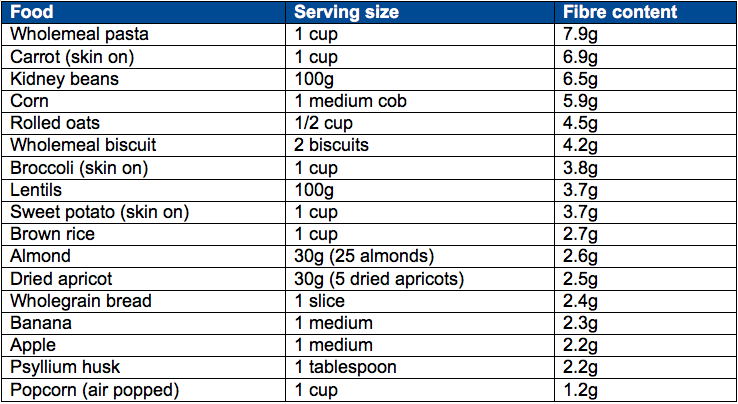


Most people would be able to answer carbohydrate, protein, fat and vitamins if they were asked to list the nutrients in our food. But fibre is also an important nutrient that often is forgotten and therefore is one that we don’t tend to get enough of. (1) Adults need around 25-30g of a variety of fibres each day for good health. (2) Luckily the different types of fibre are found in a wide range of wholefoods, so eating a varied diet will be your best bet for obtaining the whole body health benefits of fibre, such as reducing the risk of certain types of cancers and diabetes, protecting heart health and optimising bowel and gut health. (3)
Let’s look at the different types of fibre found in food and five ways to get more fibre in your diet each day.
What are the different types of fibre found in food?
Soluble Fibre
Soluble fibre gets its name because it dissolves and thickens into a gel when it comes in contact with water. This means that food moves through the digestive system slower, which can help to lower cholesterol and help regulate blood glucose levels. (3) Soluble fibre is found in the fleshy parts of fruit and vegetables, seeds, nuts, lentils, oats, barley, psyllium, lentils and legumes.
Insoluble Fibre
You might know insoluble fibre better by the name ‘roughage’. It is generally resistant to fermentation in the large intestine and helps bulk up and soften stools thereby assisting with regular bowel movements. (3) Insoluble fibre is found in the skins and seeds of fruit and vegetables, quinoa, wholegrains, millet and brown rice, as well as foods made with high-fibre ingredients such as cereals and wholemeal/wholegrain breads.
Resistant Starch
Firm bananas, wholegrains, legumes all contain resistant starch. When rice, potatoes and pasta have been cooked and cooled, they also create resistant starch. Resistant starch is the name given to fibre that is not digested in the small intestine but travels into the large intestine where it is fermented by good bacteria which help keeps the large intestine healthy and may protect against bowel cancer. (3) This video from the CSIRO provides a great visual on how resistant starch benefits our gut microbiome and protect against cancer.
How to get more fibre from wholefoods
Fruit is a source of fibre, just make sure you eat the skins on fruit (where appropriate of course – no one likes eating banana skin!) to get the insoluble fibre along with the soluble fibre of the flesh.
If fruit contains fibre, then it is not surprising that vegetables are also great sources of fibre. Depending on the type of vegetable and how it has been cooked, vegetables contain soluble and insoluble fibre as well as resistant starch. Again, leaving the skins on veggies is a great way to boost the amount of fibre eaten.
Grains generally contain insoluble fibre and resistant starch and include wheat, oats, rice, corn, barley, sorghum, rye, millet, spelt, freekeh, farro, kamut, amaranth, buckwheat and quinoa.
All of the products in the Alpine range are a source of dietary fibre with the Spelt & Sprouted Grains and Tuscany Grain being good sources of dietary fibre (contains more than 4g per serve) and our Super Natural Protein bread being an excellent source of dietary fibre (contains more than 7g per serve).
Legumes include foods such as chickpeas, lentils, mung beans, peanuts, tempeh, tofu, peas, soya beans, black beans, broad beans and baked beans. If you are following a low FODMAP diet, make sure you check your types of legumes and portion sizes carefully to ensure that you get the benefits of fibre without upsetting your tummy.
Nuts make great snacks and therefore are an easy way to quickly increase your daily fibre intake. You also get the added bonus of healthy fats, protein, and phytochemicals (these are plant chemicals that have protective or disease preventive properties). Like legumes, make sure you check your types and portion sizes if you are following a low FODMAP diet.

Table courtesy of Nutrition Australia
By eating a wide range of wholefoods every day, hitting that daily fibre intake is possible, along with all of the fantastic health benefits dietary fibre provides.
How do you get your fibre?
We’d love to hear from you so let us know in the comments section or send an email to our dietitian at info@alpinebreads.com.au
Physical activity and prevention of cancer. http://www.wcrf.org/sites/default/files/WCRFI-Matrix-for-all-cancers.pdf